
|
You entered: image
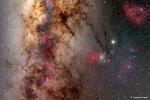 A Scorpio Sky Spectacular
A Scorpio Sky Spectacular
11.09.2007
If Scorpio looked this good to the unaided eye, humans might remember it better. Scorpio more typically appears as a few bright stars in a well known but rarely pointed out zodiacal constellation. To get a spectacular image like this, though, one needs a good camera, color filters, and a digital image processor.
 APOD is 20 Years Old Today
APOD is 20 Years Old Today
16.06.2015
Welcome to the vicennial year of the Astronomy Picture of the Day! Perhaps a source of web consistency for some, APOD is still here. As during each of the 20 years of selecting images...
 A Year of Sunrises
A Year of Sunrises
5.01.2022
Does the Sun always rise in the same direction? No. As the months change, the direction toward the rising Sun changes, too. The featured image shows the direction of sunrise every month during 2021 as seen from the city of Edmonton, Alberta, Canada.
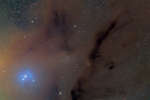 Streaming Dark Nebulas near B44
Streaming Dark Nebulas near B44
15.06.2009
Dark dust lit by the bright yellow star Antares highlight this photogenic starscape of the southern sky. A wider angle image shows the central band of our Milky Way Galaxy connected to Antares by streams of dust knows as the Dark River. At the head of the Dark River the dust appears in dense knots.
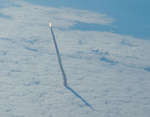 Space Shuttle Rising
Space Shuttle Rising
25.05.2011
What's that rising from the clouds? The space shuttle. If you looked out the window of an airplane at just the right place and time last week, you could have seen something very unusual -- the space shuttle Endeavour launching to orbit.
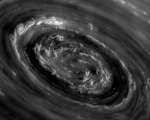 In the Center of Saturns North Polar Vortex
In the Center of Saturns North Polar Vortex
4.12.2012
What's happening at the north pole of Saturn? A vortex of strange and complex swirling clouds. The center of this vortex was imaged in unprecedented detail last week by the robotic Cassini spacecraft orbiting Saturn. These clouds lie at the center of the unusual hexagonal cloud system that surrounds the north pole of Saturn.
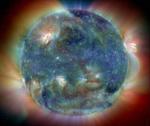 Solstice Celebration
Solstice Celebration
21.06.2000
Season's greetings! At 01:48 Universal Time on June 21 the Sun reaches its northernmost point in planet Earth's sky marking a season change and the first solstice of the year 2000. In celebration, consider this delightfully detailed, brightly colored image of the active Sun.
 Philae Lander Found on Comet 67P
Philae Lander Found on Comet 67P
12.09.2016
A little spacecraft that was presumed lost has now been found. In 2014, the Philae lander slowly descended from its parent Rosette spacecraft to the nucleus of Comet C67/P Churyumov-Gerasimenko. At the surface, after a harpoon malfunction, the lander bounced softly twice and eventually sent back images from an unknown location.
 Herschel Crater on Mimas
Herschel Crater on Mimas
13.08.2022
Mimas, small 400 kilometer-diameter moon of Saturn, is host to 130 kilometer-diameter Herschel crater, one of the larger impact craters in the entire Solar System. The robotic Cassini spacecraft orbiting Saturn in 2010 recorded...
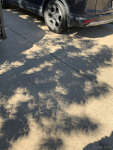 APOD: 2023 October 15 Б An Eclipse Tree
APOD: 2023 October 15 Б An Eclipse Tree
15.10.2023
Yes, but can your tree do this? If you look closely at the ground in the featured image, you will see many images of yesterday's solar eclipse -- created by a tree. Gaps between...
|
January February March April May June July |
|||||||||||||||||||||||||||||||||||||||||||||||||